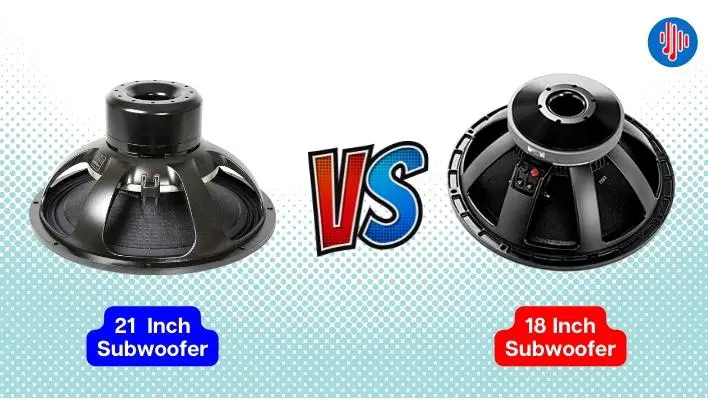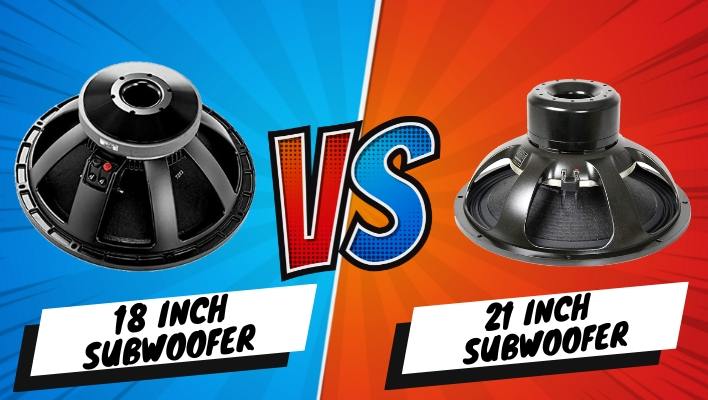If you’re an audiophile, you know that there are a lot of factors to consider when buying a subwoofer. Even if you don’t consider yourself an audiophile, as long as you love listening to music, you probably know that different kinds of subwoofers can have a significant impact on the sound quality of your home audio system (or car audio system if that’s where you listen to your music the most).
There are many different things to consider, but perhaps the most significant thing is whether or not you should buy a small subwoofer or a large one. This article will cover everything you need to know about choosing between 18 vs. 21-inch subwoofers and what kind is best for your listening environment and personal preferences.
What is the difference between 18-inch and 21-inch subwoofers?
There are some critical differences between 18-inch and 21-inch subwoofers that go beyond just the physical size of the woofer. In terms of the physical size of the subwoofer, an 18-inch subwoofer will be a bit smaller than a 21-inch subwoofer. This is because the measurement is based on the diameter of the cone. The cone will encircle the actual speaker inside the subwoofer, so an 18-inch cone will be smaller than a 21-inch cone.

A few key differences between 18-inch and 21-inch subwoofers are not related to their physical size. First, the RMS wattage and power handling of the 18-inch subwoofers are generally lower than that of a 21-inch subwoofer. This means that you can’t push an 18-inch subwoofer as hard as a 21-inch subwoofer and expect it to sound good.
Advantages of 18-inch woofers
- Smaller physical size – If you have a tight listening space and want the subwoofer to blend in with the rest of the furniture, then a smaller 18-inch subwoofer might be a better option.
- Lower wattage – If you don’t have a very powerful amplifier and don’t want to risk blowing out your 18-inch subwoofer, you might be better off with one.
- Better price – Smaller and lower-wattage subwoofers are generally cheaper than large ones, so an 18-inch subwoofer could be a better option if you’re on a tight budget.
- Better for smaller listening environments – If you have a smaller listening space, then a small subwoofer won’t overpower the rest of the audio and make it sound muddy.
- Easier to fit in car audio systems – If you have a car audio system, an 18-inch subwoofer will be a better option than a large one. Smaller subwoofers tend to be easier to fit in tight spaces.
Disadvantages of 18-inch woofers
- You can’t push it as hard – If you want to listen to music with a lot of bass, you might want to go with a large subwoofer if you want the music to be clear and not muddy.
- Lower RMS wattage – If you want to listen to music with a lot of bass, you may want to go with a large subwoofer. Large subwoofers have higher RMS wattage and can be pushed harder than small subwoofers.
- Smaller cone – A large subwoofer may be a better option if you listen to a lot of music with very low frequencies.
- Lower max SPL – If you like to go to concerts or have a loud home theater system, then a large subwoofer will be a better option. Large subwoofers have higher max SPL, so they can be turned up louder without distorting.
Advantages of 21-inch woofers
- Higher max SPL – If you like to go to concerts or have a loud home theater system, then a large subwoofer will be a better option. Large subwoofers have higher max SPL, so they can be turned up louder without distorting.
- Higher RMS wattage – If you want to listen to music with a lot of bass, you may want to go with a large subwoofer. Large subwoofers have higher RMS wattage and can be pushed harder than small subwoofers.
- Heavier cone – If you listen to a lot of music with very low frequencies, then a large subwoofer may be a better option for you.
Disadvantages of 21-inch woofers
- Larger – An 18-inch subwoofer might be better if you have a tight listening space. Large subwoofers tend to be much heavier than small ones, so they can sometimes be challenging to fit in tight spaces.
- More expensive – Large subwoofers generally cost more than small ones, so a large subwoofer may not be the best option for you if you’re on a tight budget.

Which one is better for you?
The choice between a 21-inch subwoofer vs an 18-inch subwoofer is a difficult one. Both have pros and cons that must be considered before making a decision. The size of the room, the type of music being played, and the budget are all important factors in this decision.
If budget is not an issue, then the 21-inch subwoofer is usually the better choice. It offers more power and bass than the 18-inch model. This makes it ideal for large rooms or people who want to feel the power of their music. However, it can be too much for smaller rooms or those who prefer a subtler sound.
The 18-inch subwoofer is a good compromise between power and size. It still offers good bass response but without being too overwhelming. This makes it a good choice for medium-sized rooms or people who want decent bass without spending much money.
Summary
All in all, many different factors go into choosing between an 18-inch subwoofer and a 21-inch subwoofer. To find the best sub for your listening environment and personal listening preferences, you’ll first have to determine the kind of bass you want in your audio. Do you want your audio to be subtle and smooth, or do you want it to be loud and in your face? Once you figure that out, you can begin to look at the specifications of different subwoofers. From there, you can decide which subwoofer fits your needs best based on its physical size, RMS wattage, max SPL, and price.
